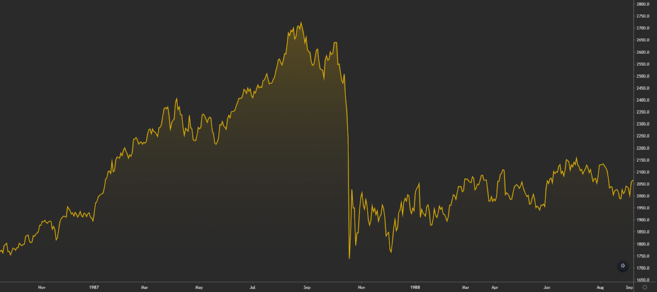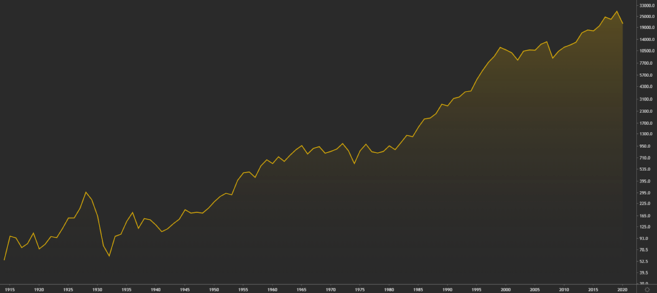What is Black Monday?
Black Monday is the name used to describe a sudden and severe stock market crash that occurred on October 19, 1987. The Dow Jones Industrial Average (DJIA), an index that measures the performance of the U.S. stock market, fell by more by 22%. The crash was preceded by two other significant falls a week earlier.

Performance of the Dow Jones Industrial Average around Black Monday.
Black Monday is remembered as the start of a decline in the global stock market. To this day, it is one of the most infamous days in the history of the stock markets.
The total trading volume on the exchanges was so high that computers at the time were unable to handle the sudden heavy load. Orders were not executed for hours and large transfers of funds were delayed.
A major crash like this is naturally tracked in the futures and options markets. The crash also had a significant impact on global markets. Most of the world's major indices fell between 20 and 30% before the end of the same month.
The phrase "Black Monday" generally refers to the crash of 1987. But it is also used to refer to other serious market crashes.
What are the causes of market crashes?
In general, the cause of stock market crashes cannot be attributed to a single factor. Interestingly, no major event preceded Black Monday in 1987. However, several different factors came together to create an atmosphere of panic and uncertainty. So what were these factors?
The first was the introduction of computerized trading systems. Today, most trading is done by computer, but this was not always the case. Before the 1980s, stock markets were typically noisy and crowded, where traders traded assets directly in the exchange's trading room.

The trading floor of the New York Stock Exchange (NYSE) in 1963, before the introduction of computerized trading systems. Source: Library of Congress. Image modified from the original.
Throughout the 1980s, however, trading activity relied increasingly on computer software. The move to computerized trading has enabled much faster trading activity with systems capable of placing thousands of orders in seconds. Naturally, these advances have also affected the speed of significant price movements. For comparison, today's trading robots can move trillions of dollars of value in seconds after an unexpected event.
Other factors, such as the United States trade deficit, international tensions, and other geopolitical circumstances, have also been cited as causes. Additionally, the growing media reach certainly amplified the effects and severity of the event.
It should be noted that while all of these factors may have contributed to the accident, decisions were nevertheless made by people. Market psychology plays a major role in sales, and it is often simply mass panic.
What is a circuit breaker?
Following the events of Black Monday, several mechanisms were put in place by the United States Securities and Exchange Commission (SEC) to prevent similar events from happening again. Or if it is impossible to prevent them, to at least lessen their impact.
One of these methods is called the circuit breaker. This is a regulatory measure that halts trading when the price reaches certain percentage levels from the daily open. While we are talking primarily about the United States here, circuit breakers have also been implemented in many other markets.
Circuit breakers apply to major indexes such as the Dow or S&P 500, as well as individual stocks. Here's how they work.
If the S&P 500 declines more than 7% during a trading day, trading is halted for 15 minutes and then restarted. This is a level 1 circuit breaker. If the market falls further and reaches 13% from the daily open, it is shut down again. This is called a level 2 circuit breaker. Then, after a 15 minute break, trading is restarted. If the price reaches a 20% loss from the market open, trading is halted for the remainder of the day. This is called a level 3 circuit breaker.
Advantages and disadvantages of circuit breakers
While circuit breakers can be effective in preventing flash crashes, they have been the subject of controversy.
Some critics of circuit breakers say they have a negative effect on markets and actually increase the severity of accidents. How so ? As these predetermined percentage levels are based on the open market, they are publicly known. Thus, they can affect order placement and artificially decrease liquidity in the order book at certain price levels.
Decreased liquidity can lead to more volatility because there may not be enough orders to absorb an unexpected spike in supply. Critics argue that without the influence of circuit breakers on liquidity zones, markets are more likely to reach a natural equilibrium.
When it comes to global market indices such as the S&P 500, circuit breakers are only triggered on downward movements. On the other hand, they can be activated on individual securities during upward movements as well.
How to Prepare for a Market Crash
Due to the nature of markets and mass psychology, accidents are almost inevitable. But what can you do to prepare for a market crash?
Consider creating an investment plan or overall trading strategy. When the market crashes and many investors are panic selling, it is important to remain calm, rational and avoid emotional decisions. Creating a long-term investment plan or trading strategy is essential for this, as it should not allow you to make impulsive decisions.
Another thing to consider is setting a Stop-loss. Protecting your downside investment from short-term trading is essential to success. However, this practice is surprisingly less common when it comes to long-term investors. Even if your Stop-Loss leaves room for larger price swings, it could save you from big losses in the event of a devastating market crash.
As for global market crashes, they have all been temporary so far. Although economic recessions can last for several years, markets tend to recover afterward. If you zoom out far enough, the global economy has been growing steadily for centuries, and these corrections are just temporary setbacks.

Performance of the Dow Jones Industrial Average between 1915 and 2020.
While this observation may be correct for global markets linked to economic growth, it does not apply to cryptocurrency markets. The blockchain industry is still young and cryptocurrencies are a risky asset class. Therefore, it is possible that some crypto assets may never recover from a market crash.
Do you want to get started with cryptocurrencies? Buy Bitcoin on Binance!
Other notable Black Mondays
October 28, 1929
Stock markets crashed, preceding the Great Depression of the 1930s. Given its long-term economic effects, this crash was the most destructive of stock markets to date.
September 29, 2008
After the housing bubble burst in the United States, stock markets began to collapse. This ultimately led to the Great Recession of the late 2000s and early 2010s. If you want to learn more, check out The Financial Crisis of 2008.
9 mars 2020
The worst day for the U.S. stock market since the Great Recession, fueled by the coronavirus pandemic and an oil price war. At the time, it was the largest single-day drop since 2008. But, as you'll see in the next paragraph, that record only held for a single week.
16 mars 2020
Fears about the potential economic effects of the coronavirus pandemic have continued to rise. As a result, the US market saw an even bigger drop in a single day than during the previous week's crash. That day can be considered the peak of the initial impact of the coronavirus on financial markets.
To conclude
Ultimately, Black Monday was a serious market crash in 1987. As mentioned, the term can also be used to refer to other stock market crashes, such as those in 1929, 2008, and 2020.
Following the events of Black Monday, new regulations were implemented to try to mitigate the effects of instant stock market crashes. One of the most influential and controversial of these regulations is the circuit breaker, which halts trading when predefined loss levels are reached.
But what can you do to prepare for a market crash? Think about possible scenarios to develop a suitable investment plan or trading strategy. Risk management, portfolio diversification, and market psychology are a few topics that can help you avoid big losses during market crashes.








